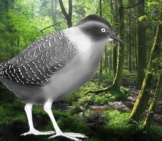The Black Rail is a tiny member of the Rallidae family. Some of their closest relatives include coots, gallinules, crakes, and of course other rails. They are about the size of a mouse, and their feathers are gray and rusty brown.
These little birds live in scattered populations across different regions in North, Central, and South America. Read on to learn about the Black Rail.
Description of the Black Rail
The Black Rail is actually not black at all! This bird’s head and chest are gray colored, and the rest of its body is rusty brown. Across the rust colored portion of its feathers, there are small light-colored speckles.
These birds’ legs are relatively long in comparison to the rest of their bodies, though not as long as a heron or egret. They also have distinct red eyes, and black bills. They are about five or six inches long, and weigh about an ounce or so.
Interesting Facts About the Black Rail
Black Rails are rare little birds, and they only live in small pockets across their range. Learn what makes this mysterious bird unique below.
- Shallow Water – Most rail species forage through relatively deep waters, and some species can even swim. Black Rails prefer extremely shallow areas where they can wade comfortably. Their favorite habitats are the edges of marshes and wetlands.
- Rare Sighting – Because they are so small, and very adept at hiding in the reeds and shrubs, they are difficult to spot! In fact, you are much more likely to hear one than you are to see one. At sundown, these birds make territorial calls to one another. Listen for the sound of a “kick-ee-doo” vocalization as the sun sets.
- Under Threat – It is difficult for researchers to determine just how many of these birds there are, simply because it is so hard to find them! However, scientists believe that their populations are on the decline. Habitat destruction can quickly annihilate an entire population in a single region.
Habitat of the Black Rail
These birds live primarily in semi-aquatic habitats. Their favorite places to live and nest are wetlands, marshes, and flooded meadows. They only live in areas with dense vegetation to hide in.
Some populations live in freshwater, while others live in salt or brackish water habitats. Populations in different regions have different preferred habitat types.
Distribution of the Black Rail
Researchers aren’t quite sure of this species’ exact distribution. There are many small pockets where these birds live, but they are few and far between throughout their range. In North America, Black Rails live along the east coast from New Jersey to Florida.
There are also populations along the coast of Texas and California. Some isolated populations live in Colorado and Kansas. Several breeding populations also live in various parts of Mexico, Central America, and South America.
Diet of the Black Rail
This species is quite small, so the type of food it can eat is limited. Their primary foods are seeds and small invertebrates. Some examples of likely prey include flies, mosquitos, insect larvae, worms, spiders, and more. Because it is difficult for researchers to study these elusive creatures, little is known about the exact types of prey that they eat.
Black Rail and Human Interaction
Scientists are unsure exactly how much human interaction impacts this small bird. Their populations are small and fragmented through most of their range.
The primary threat to this species is the destruction of their wetland habitats. These birds can only survive in dense wetlands, so when humans destroy their habitats, their populations decrease. The IUCN lists the Black Rail as Near Threatened for these reasons.
Domestication
Humans have not domesticated these birds in any way.
Does the Black Rail Make a Good Pet
No, Black Rails do not make good pets. They are secretive and reclusive birds, which only thrive in dense wetland habitats. Additionally, it is illegal in most places to own any species of rail as a pet.
Black Rail Care
Not many zoos have Black Rails in their collection. However, we can assume that their care would be similar to that of other small rail species. Their enclosures must have shallow waters for them to explore, and lots of dense vegetation to hide in.
Because we don’t know their precise diet, we cannot say for sure what type of diet would be necessary to keep them healthy.
Behavior of the Black Rail
Researchers know virtually nothing about the social life or day-to-day behavior of these birds. Finding them, nonetheless observing them, is quite difficult in the wild.
They prefer areas with dense vegetation, and rarely leave the safety of cover. Though they can fly, they spend most of their time walking on the ground between the reeds and shrubs.
Reproduction of the Black Rail
During the breeding season, male Black Rails defend territories. Within those territories, the male will breed with several females. They build their nests on the ground in dense vegetation.
Females lay between six and eight eggs, and both parents incubate them for about three weeks. Researchers are unsure how long it takes for the young chicks to learn how to fly.

![Painting of a Black Rail, by Louis Agassiz Fuertes Painting of a Black Rail Image by: Louis Agassiz Fuertes [Public domain]](https://animals.net/wp-content/uploads/2019/06/Black-Rail-1-650x425.jpg)

![Drawing of a Black Rail Image by: Danika Tsao, USGS [Public domain]](https://animals.net/wp-content/uploads/2019/06/Black-Rail-2-650x425.jpg)
![Painting of a Black Rail, by Louis Agassiz Fuertes Painting Of A Black Rail Image By: Louis Agassiz Fuertes [Public Domain]](https://animals.net/wp-content/uploads/2019/06/Black-Rail-1-162x141.jpg)

![Drawing of a Black Rail Image by: Danika Tsao, USGS [Public domain] Black Rail 2](https://animals.net/wp-content/uploads/2019/06/Black-Rail-2-162x141.jpg)
![Red Angus Closeup of a beautiful Red Angus cowPhoto by: U.S. Department of Agriculture [pubic domain]https://creativecommons.org/licenses/by/2.0/](https://animals.net/wp-content/uploads/2020/03/Red-Angus-4-238x178.jpg)












![Red Angus Closeup of a beautiful Red Angus cowPhoto by: U.S. Department of Agriculture [pubic domain]https://creativecommons.org/licenses/by/2.0/](https://animals.net/wp-content/uploads/2020/03/Red-Angus-4-100x75.jpg)

